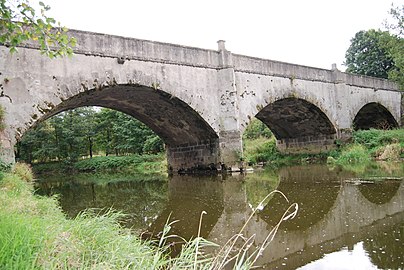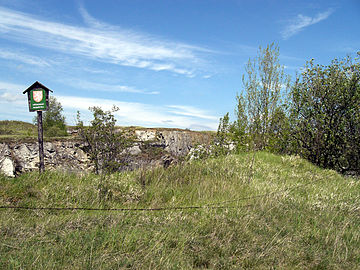Dolní Nerestce
| Dolní Nerestce | ||||
|---|---|---|---|---|
|
||||
| Basic data | ||||
| State : |
|
|||
| Region : | Jihočeský kraj | |||
| District : | Písek | |||
| Municipality : | Nerestce | |||
| Area : | 256 ha | |||
| Geographic location : | 49 ° 30 ' N , 14 ° 4' E | |||
| Height: | 438 m nm | |||
| Residents : | 70 (March 1, 2001) | |||
| Postal code : | 398 06 | |||
| License plate : | C. | |||
| traffic | ||||
| Street: | Prague - Strakonice | |||
| Railway connection: | Protivín – Zdice | |||
| Next international airport : | České Budějovice Airport | |||
Dolní Nerestce (German Unter Nerestetz ) is a district of the municipality Nerestce in the Czech Republic . It is located three kilometers southwest of Mirovice and belongs to the Okres Písek .
geography
Dolní Nerestce is located on the left bank of the Skalice in the Central Bohemian hill country. To the east of the village runs the state road I / 4 between Prague and Strakonice , on the opposite bank of the river the Protivín – Zdice railway runs through Horní Nerestce. The Pahorek (456 m) rise to the southeast, the Na Doubravici (466 m) to the south, the Jezvinec (545 m) to the southwest and the Hradec (477 m) to the west.
Neighboring places are Horosedly in the north, Lety , Pod Homolí and Pazderna in the north-east, Králova Lhota in the east, Laziště, Nový Dvůr, Spálenský Mlýn, Doubravičky and Krsice in the south-east, Horní Nerestce , Čimelice and Rakovice in the south, Kakovice iště in the south-west West and Kuchařův Mlýn, Zámostí and Mirovice in the north-west.
history
Archaeological finds on the castle grounds show that the left bank of the river was settled in the 8th and 9th centuries.
The first written mention of the village Neřestce in the province of Bozeň was in 1227 as the property of the St. George monastery at Prague Castle . There are different interpretations for the origin of the place name. Antonín Profous directed it from osada neřestníků ( settlement of vice ), other interpretations are based on the old Czech nerast ( boar ). The royal vassal Ubizlaus de Neresticz can be traced between 1336 and 1341, to whom King John of Luxembourg granted the privilege of soaping gold in the Skalice near Stěžov, Radětice and Palivo. In 1363 Beneš and Ubislav from Nerestce were mentioned, in 1398 Jan from Nerestce and in the following year Václav and Ubislav from Nerestce. In the 15th century there was a feudal yard of the Klingenberg Castle in Nerestce , which also included two mills. In 1474 Jan Tluksa from Vrábí on Kašperk bought the Nerestce feudal estate with the forecourt of Markvart von Rakovice and added it to his Čimelice estate . From 1543 the knights Deym von Střitetz owned the estate. After the death of Alesch Deym von Střitetz in 1597 there was a division of property in which the Nerestce estate fell to his son Johann the Younger. At the beginning of the 17th century, Johann and his brother Wilhelm had the fortress converted into a stone castle. After the Battle of the White Mountain , Johann d. J. Deym von Střitetz sentenced in 1623 to the loss of ownership of Nerestce because of his participation in the uprising and the estate fell back into a feudal relationship. After his death, the feud was withdrawn in 1629 and sold to him the following year to Eva Ploth von Konařin, née Deym von Střitetz, who had also acquired Čimelice. It failed to restore the goods that had been ruined by the Thirty Years' War to a profitable state. After her death, Alesch Karl Ploth von Konařin sold the Nerestce estate to Wilhelm Racek Hrobschitzky von Hrobschitz in 1663 and only kept Čimelice. Hrobschitzky was also unable to run the estate economically, so that it was foreclosed in 1679 due to excessive indebtedness. The new owner was Peter Ignaz Říčanský of Říčany, followed in 1687 by Johann Anton Kořenský of Terešov and then by Josephine von Conens, née Tejřovská von Einsiedl.
In 1719, the captain of the Prachin district , Karl Gottlieb Baron von Bissingen, bought the Nerestce estate and added it to his lord Čimelice. In 1742 his son Karl Gottfried Graf von Bissingen inherited the property. He died on January 4, 1771 without male descendants. His widow Maria Appollonia, née Countess Wratislaw von Mitrowitz , became the universal heiress . In 1782 she appointed her brother Prokop Imperial Count Wratislaw von Mitrowitz as heir of Čimelitz. This sold the rule in 1798 to his nephew Joseph Imperial Count Wratislaw von Mitrowitz. In 1834 Joseph Wratislaw's widow Gabriele, née Countess Desfours, inherited the rule and transferred it to the administration of her son-in-law Karl II, Prince of Schwarzenberg on Worlik . In 1837 Unter-Nerestetz or Dolegssj Nerestec consisted of 25 houses with 163 inhabitants. The parish was Mirotitz . North of the village, the lordship operated a limestone quarry. Until the middle of the 19th century Unter-Nerestetz remained subordinate to the allodial rule Čimelitz, including Straschowitz and Slawkowitz.
After the abolition of patrimonial Dolní Neřestec / Unter-Nerestetz formed from 1850 a district of the municipality Čimelice in the district administration Písek and the judicial district Mirovice. On February 21 of the same year Gabriele Wratislaw von Mitrowitz's sister Josefina Marie bequeathed the Čimelitz estates to her son Karl III. Prince of Schwarzenberg. On April 24, 1874 Dolní Neřestec broke away from Čimelice and formed its own community. Since the beginning of the 20th century, Dolní Nerestce or Dolní Neřestce , since 1924 only the former, were used as the official place names. The voluntary fire brigade was founded in 1913. In 1919 Dolní Nerestce and Horní Nerestce merged to form the Nerestce municipality. Nerestce was incorporated into Horosedly on April 1, 1976 and on January 1, 1983 together with this to Mirovice. Both districts broke away from Mirovice on November 24, 1990 and reunited to form the Nerestce municipality. In 1991 Dolní Nerestce had 76 inhabitants, at the 2001 census there were 70 people in the 43 houses.
Attractions
- Dolní Nerestce Castle, the fortress that has existed since the 13th century, was redesigned in the 16th century by the knights Deym von Střitetz into a two-wing Renaissance castle, with the east wing containing the old fortress in its core. In the 18th century the chapel of St. Anna. When the manor was annexed to the Čimelice rulership in 1719, it lost its importance as a manor. Legends tell of an alleged underground secret passage to Lety and Orlík Castle. In 1921 and 1946 it was converted into a residential building. The castle is now privately owned and is one of the cultural monuments of the Okres Písek.
- Three-arched stone bridge over the Skalice, it received its current design in Empire style in 1814. On the six meter wide bridge there are statues of the Holy. Barbara, Maria Magdalena, Wenzel, Aegidius, Veit, Sigismund, Johannes von Nepomuk and Josef, who belong to the sculptor's hut of Jan Hammer in Čimelice. The span of the two side arches is 12 meters, that of the central arch 13 meters. During the Napoleonic Wars, the bridge was intended to be blown up when the French withdrew in 1813, and appropriate loading chambers were found in the bridge piers. The bridge is also one of the cultural monuments of the Okres Písek. The original figures were deposited in Čimelice and will be replaced by copies in the future. The traffic on the state road now runs over a parallel modern road bridge.
- Nerestský lom natural monument, former limestone quarry north of Dolní Nerestce
- Wayside shrine at the end of the village to Horosedly
- Several farmsteads in peasant baroque style from the 19th century
- Memorial to the fallen of the Second World War
- Attractions
Web links
Individual evidence
- ^ Johann Gottfried Sommer : The Kingdom of Böhmen, Vol. 8 Prachiner Kreis , 1840, p. 41





